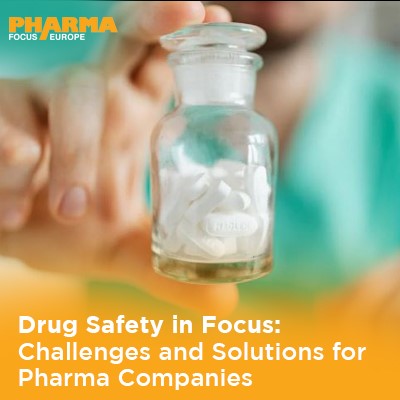
Drug safety is crucial for pharmaceutical companies, involving challenges like adverse event monitoring, data management, regulatory compliance, and patient reporting. Solutions include advanced pharmacovigilance systems, real-time monitoring, big data analytics, patient-centric approaches, collaborative partnerships, continuous training, risk communication, and robust post-marketing surveillance to ensure patient well-being and regulatory compliance.

Drug safety is a paramount concern for pharmaceutical companies worldwide. Ensuring the safety and efficacy of medications is not only a legal requirement but also a moral obligation towards patient welfare. In this comprehensive guide, we delve into the challenges faced by pharma companies in drug safety and explore innovative solutions to enhance safety protocols and protect patient health.
Challenges in Drug Safety
1. Adverse Events Monitoring: One of the primary challenges in drug safety is the effective monitoring of adverse events post-drug approval. Despite rigorous clinical trials, unforeseen side effects may emerge once a drug enters the market, necessitating real-time monitoring mechanisms. Implementing sophisticated adverse event monitoring systems that can analyze large volumes of data in real-time is essential.
2. Data Management: The sheer volume of data generated in pharmacovigilance poses a significant challenge. Pharma companies must streamline data management processes to identify and respond promptly to potential safety issues. Utilizing advanced data analytics tools and cloud-based platforms can aid in efficient data management and analysis.
3. Regulatory Compliance: Adhering to stringent regulatory standards is a constant challenge for pharma companies. Compliance with diverse international regulations adds complexity to drug safety strategies. Investing in regulatory expertise and leveraging technology for automated compliance checks can streamline regulatory processes.
4. Signal Detection: Detecting signals of potential safety concerns amidst vast data sets requires advanced analytics and signal detection algorithms. Pharma companies need robust systems to differentiate between random events and genuine safety signals. Implementing AI-driven signal detection tools enhances the accuracy and efficiency of signal detection processes.
5. Patient Reporting: Encouraging patients to report adverse events directly poses a challenge. Many patients may not be aware of reporting mechanisms or may hesitate to report due to lack of understanding or fear of repercussions. Developing user-friendly reporting portals and providing education on the importance of reporting can facilitate increased patient engagement in pharmacovigilance activities.
Solutions for Enhancing Drug Safety
a. Advanced Pharmacovigilance Systems: Implementing state-of-the-art pharmacovigilance systems powered by artificial intelligence (AI) and machine learning (ML) algorithms can enhance adverse event detection and signal prioritization. These systems can analyze structured and unstructured data sources, including social media and medical literature, to identify potential safety signals.
b. Real-Time Monitoring: Leveraging technologies for real-time monitoring of adverse events allows pharma companies to intervene promptly and mitigate potential risks to patient safety. Continuous monitoring of safety databases and automated alerting systems enable proactive risk management strategies.
c. Big Data Analytics: Harnessing the power of big data analytics enables pharma companies to extract valuable insights from large data sets, facilitating proactive risk management and safety surveillance. Predictive analytics models can forecast potential safety issues based on historical data patterns, enabling preemptive measures.
d. Patient-Centric Approach: Adopting a patient-centric approach to pharmacovigilance encourages active patient participation in reporting adverse events, fostering transparency and trust. Patient feedback and insights play a crucial role in identifying rare or unique adverse reactions that may not be captured in clinical trials.
e. Collaborative Partnerships: Collaborating with regulatory agencies, healthcare providers, and other stakeholders fosters a collaborative environment for sharing safety data and implementing best practices. Cross-industry collaborations can lead to the development of standardized safety protocols and enhanced communication channels.
f. Continuous Training and Education: Investing in ongoing training and education programs for healthcare professionals, patients, and internal staff promotes awareness about drug safety protocols and reporting mechanisms. Training modules on pharmacovigilance best practices, adverse event management, and risk communication empower stakeholders with the knowledge and skills needed for effective safety management.
g. Risk Communication: Developing clear and concise risk communication strategies ensures that patients and healthcare professionals are well-informed about potential risks associated with medications. Transparent communication channels, including patient information leaflets, medication guides, and online resources, facilitate informed decision-making and risk mitigation.
h. Post-Marketing Surveillance: Strengthening post-marketing surveillance through enhanced pharmacovigilance activities enables early detection of safety signals and facilitates timely risk mitigation strategies. Robust pharmacovigilance programs that integrate feedback loops for continuous improvement enhance drug safety monitoring throughout the product lifecycle.
In conclusion, drug safety is a multifaceted endeavor that requires proactive measures, innovative technologies, and collaborative efforts across the pharmaceutical industry. By addressing the challenges and implementing robust solutions outlined above, pharma companies can uphold the highest standards of drug safety and ultimately safeguard patient well-being. Achieving a comprehensive and effective drug safety framework not only enhances regulatory compliance but also builds trust among patients and healthcare providers, fostering a safer and more resilient healthcare ecosystem.